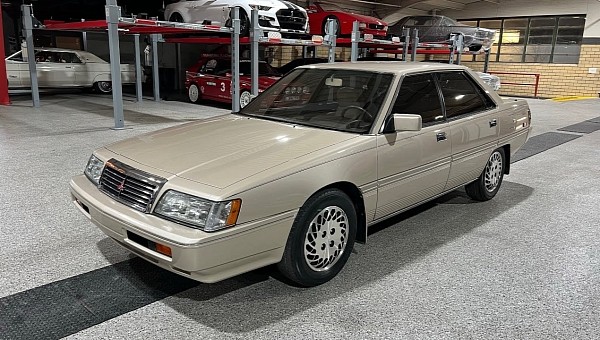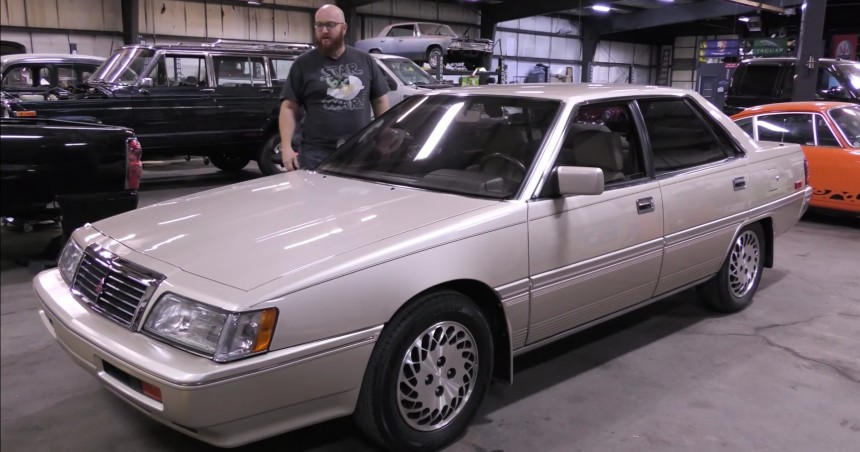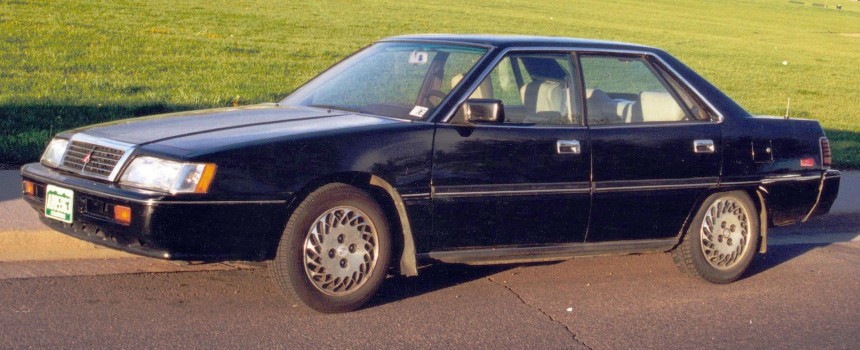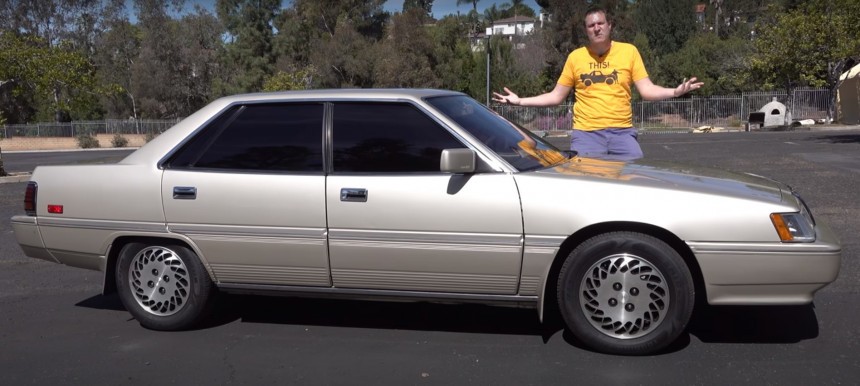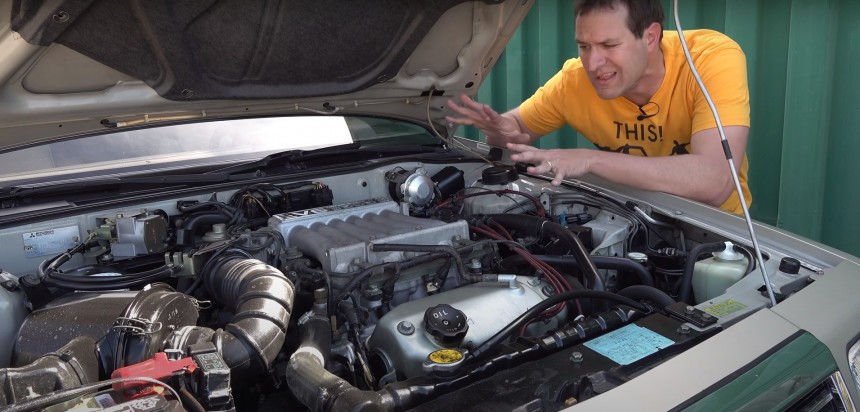We love Mitsubishis around here. That's despite the laundry list of faults we could point to, showing the company is going in the opposite direction it should be at this juncture. You hear a lot of talk about a lack of identity with Mitsubishi today. This tends to happen when your lineup shares parity with two other brands.
Such is the way things are in the Renault-Nissan-Mitsubishi corporate love triangle. But in the late 80s and early 90s, Mitsubishi was a much different company than we're used to now. The company mentality was altogether different when they were saving Chrysler from the grave by collaborating with Lee Iacocca. Look at the USDM fifth-generation Mitsubishi Sigma if you don't believe us.
Not that this is inherently a disingenuous trait for a Japanese import to have. Mitsubishi was a company on the precipice skyrocketing in U.S. market sales in the late 1980s. The first parts of the decade were spent seeding the U.S. Domestic Market with cheap but dependable vehicles like the Tredia Sedan, the Cordia compact, and the Starion sports coupe. Oh, and how could we forget the pint-sized Mighty Max light pickup truck?
It was perhaps the perfect time for the company to tinker with a full-sized, luxury-adjacent sedan, a la the Mercedes-Benz C-Class or the Audi 5000. It could take a chunk out of the Toyota Camry and Nissan Maxima's market share, if nothing else. Unlike JDM and Euro-spec Galants of the late 80s, the export Sigma sported a unique six-window layout with market-specific interior and exterior trim pieces.
At least by looking at the specs, there was at least an attempt to shove some neat tech underneath the handsome-looking bodywork in the Sigma. Mitsubishi was hardly known for refinement or high standards of interior features in the late 80s. At least, that was the case in the United States. In Japan, where automakers routinely hog their flagship car models for themselves, things were altogether different.
In the States, the nearly 3,500-lb (1,587.5-kg) Sigma left the factory with the 3.0-liter Mitsubishi 6G72 engine. If you're a fan of the 3000GT sports car, you'll know its base model also sported this engine. As did many early-90s variants of the Plymouth Voyager, Chrysler Town & Country, and the Dodge Caravan. This was during the period when Mitsubishi had, perhaps, its heaviest hand in aiding Chrysler.
Ironically, the brake master cylinder under the hood of the USDM Sigma was located on the passenger side of the vehicle. That's unlike most U.S. market vehicles, which place them directly in front of the steering column. It just goes to show just how many places worldwide Mitsubishi sold this car. Evidently, with varying degrees of success.
This was nothing short of a world-altering engine for Mitsubishi. A powertrain that saw the company rise to become one of the fastest-growing North American automotive brands in the 20th century. 142 horsepower and 160 lb-ft (217 Nm) of torque were what you had to play with in the USDM Sigma. Admittedly, this was slightly down from European and JDM variants with different drivetrain choices. The engine is paired with a four-speed automatic transmission with overdrive which is operated by an uncannily chunky gear stick.
Further trinkets like plush, comfortable seats dressed in blue velour or leather in either tan or ivory color made for quite a nice place to sit. Said seats were lined with tasteful shiny chrome trim around its outer dimensions. It matches the chrome exterior trim pieces very nicely. Radio controls integrated into the bottom of the Sigma's steering wheel paved the way for such tech to become standard on modern vehicles.
Though the microwave-style blister buttons for the climate control were an odd choice for sure. What wasn't an odd choice at all was the absolutely massive rear-seat cargo pass-through which makes those in other cars look positively tiny. Why a Japanese luxury sedan has a cargo pass-through you could legitimately fit strips of particle board inside is anyone's guess. But it's pretty darn practical. There are no arguments there.
You get the sense that Mitsubishi knew Toyota was ready to take the U.S. by storm with Lexus in the late '80s. Evidently, Mitsubishi was aiming for the same success in the luxury car market without its own bespoke luxury brand. Sadly, it turns out that upgrading a Toyota badge to a Lexus was like turning a Chevrolet into a Cadillac in North American terms. This image made early Lexus stalwarts like the LS and the ES cell in vastly better numbers than any Mitsubishi luxury car.
This brings us to the gen-V American Mitsubishi Sigma in relation to what's the company's become today. There's a sense Mitsubishi simply lacks the same zest for interesting designs and clever technology that saw the company become an American juggernaut 30 years ago. Once the company was merged into the already problematic Renault-Nissan merger, it was clear that trademark refinement that made the Sigma and so many other Mutsibishis unique was being sacrificed in the name of wider profit margins.
Mitsubishi has the ability to recapture that passion for genuinely clever design once again if it feels inclined to. Not to say it necessarily needs another full-sized luxury sedan to find itself again. It could be a truly world-beating SUV to beat the Toyota 4Runner, or maybe a spiritual successor to the old Mighty Max truck. Or, heaven willing, we could have our long-awaited Evo 11.
But with EVs now the new norm, we think a Sigma successor is a bit less pie-in-the-sky. We're looking at you, Mitsubishi. We know you can do better. That's why it pains us so much that they can't seem to get their collective you-know-what together. If they don't step their game up, chances are good Mitsubishi won't last much longer in North America. Based on how pleasantly charming the classic Galand and Sigma used to be, that'd be a tragedy in more ways than one. But enough being a downer, let's pray for Mitsubishi to pull through.
Check back soon for more classic JDM profiles here on autoevolution.
Mitsubishi at the top of their game
On first impressions alone, the top-of-the-line variant of the USDM gen-V Mitsubishi Galant, the Sigma, is a remarkably striking vehicle. The iconic red tri-star that'd one day complete the look of the Lancer Evolution rally cars may have been prominent on the Sigma's front grille. But come on now. The thing looks like a cross between a Mercedes-Benz S-Class and a mid-80s Lancia Gamma. So to speak, the Sigma was JDM homebody that wanted you to think it was European.Not that this is inherently a disingenuous trait for a Japanese import to have. Mitsubishi was a company on the precipice skyrocketing in U.S. market sales in the late 1980s. The first parts of the decade were spent seeding the U.S. Domestic Market with cheap but dependable vehicles like the Tredia Sedan, the Cordia compact, and the Starion sports coupe. Oh, and how could we forget the pint-sized Mighty Max light pickup truck?
It was perhaps the perfect time for the company to tinker with a full-sized, luxury-adjacent sedan, a la the Mercedes-Benz C-Class or the Audi 5000. It could take a chunk out of the Toyota Camry and Nissan Maxima's market share, if nothing else. Unlike JDM and Euro-spec Galants of the late 80s, the export Sigma sported a unique six-window layout with market-specific interior and exterior trim pieces.
A truly global full-size sedan
In the Far East, the Mitsubishi Debonair executive limousine, made at the same time as the USDM Sigma, was one of the sweetest and most luxurious domestic cars on sale. It's clear a little bit of the Debonair's mystique managed to find its way across the ocean to the States. That said, the Debobnair's 2.0-liter V6 engine was too puny for American car buyers of the day to feel comfortable driving.In the States, the nearly 3,500-lb (1,587.5-kg) Sigma left the factory with the 3.0-liter Mitsubishi 6G72 engine. If you're a fan of the 3000GT sports car, you'll know its base model also sported this engine. As did many early-90s variants of the Plymouth Voyager, Chrysler Town & Country, and the Dodge Caravan. This was during the period when Mitsubishi had, perhaps, its heaviest hand in aiding Chrysler.
Ironically, the brake master cylinder under the hood of the USDM Sigma was located on the passenger side of the vehicle. That's unlike most U.S. market vehicles, which place them directly in front of the steering column. It just goes to show just how many places worldwide Mitsubishi sold this car. Evidently, with varying degrees of success.
A very competitive offering for the time
Fuel economy was estimated at around 18 MPG in the city and 22 on the highway in U.S. market Sigmas. Pretty mediocre by modern standards but not awful for a 35-year-old luxury barge. As for the suspension in the Sigma, it's a novel self-leveling unit. This was a trademark feature of the established German luxury cars like the Mercedes-Benz W124, another signifier Mitsubishi meant business with their Sigma.Further trinkets like plush, comfortable seats dressed in blue velour or leather in either tan or ivory color made for quite a nice place to sit. Said seats were lined with tasteful shiny chrome trim around its outer dimensions. It matches the chrome exterior trim pieces very nicely. Radio controls integrated into the bottom of the Sigma's steering wheel paved the way for such tech to become standard on modern vehicles.
Though the microwave-style blister buttons for the climate control were an odd choice for sure. What wasn't an odd choice at all was the absolutely massive rear-seat cargo pass-through which makes those in other cars look positively tiny. Why a Japanese luxury sedan has a cargo pass-through you could legitimately fit strips of particle board inside is anyone's guess. But it's pretty darn practical. There are no arguments there.
Proof Mitsubishi used to make great cars
The USDM gen-V Sigma only lasted from 1988 until 1990. Official production numbers for these years are hard to come by. But to simplify things, the similarly-sized Lexus ES is still very much with us today and still averages yearly sales between 40 to 50 thousand vehicles. Meanwhile, the most luxurious sedan Mitsubishi has in their lineup in 2023 is the lowly Mirage G4. That's because it's the only sedan Mitsubishi sells in North America anymore.This brings us to the gen-V American Mitsubishi Sigma in relation to what's the company's become today. There's a sense Mitsubishi simply lacks the same zest for interesting designs and clever technology that saw the company become an American juggernaut 30 years ago. Once the company was merged into the already problematic Renault-Nissan merger, it was clear that trademark refinement that made the Sigma and so many other Mutsibishis unique was being sacrificed in the name of wider profit margins.
Mitsubishi has the ability to recapture that passion for genuinely clever design once again if it feels inclined to. Not to say it necessarily needs another full-sized luxury sedan to find itself again. It could be a truly world-beating SUV to beat the Toyota 4Runner, or maybe a spiritual successor to the old Mighty Max truck. Or, heaven willing, we could have our long-awaited Evo 11.
Check back soon for more classic JDM profiles here on autoevolution.
